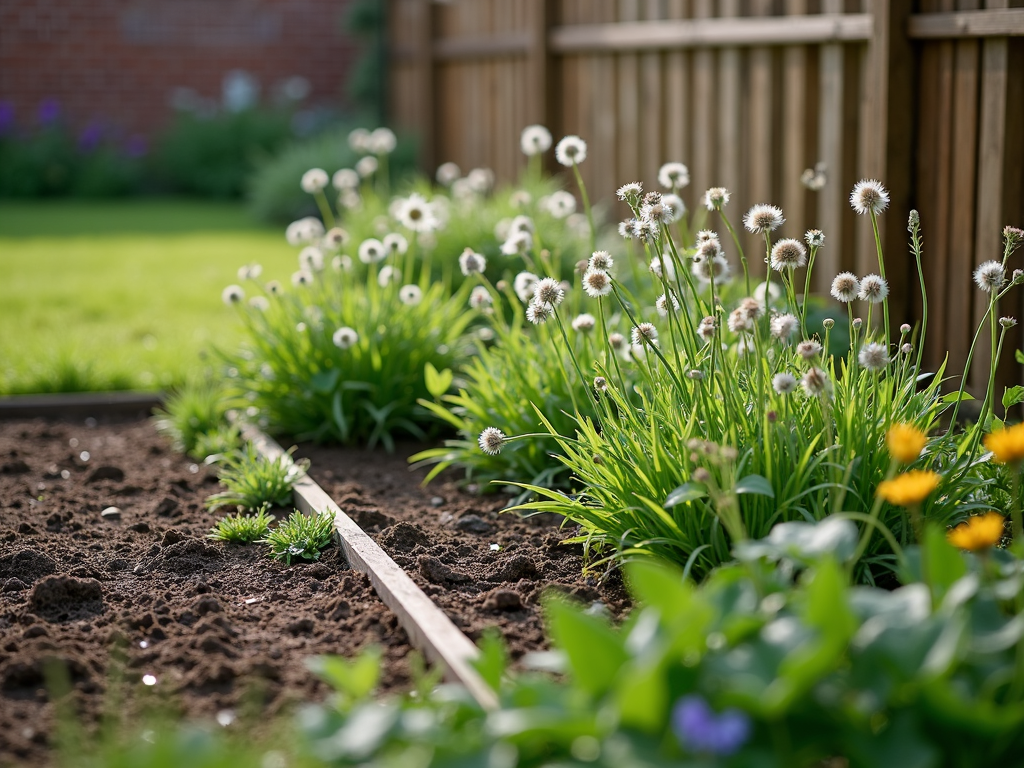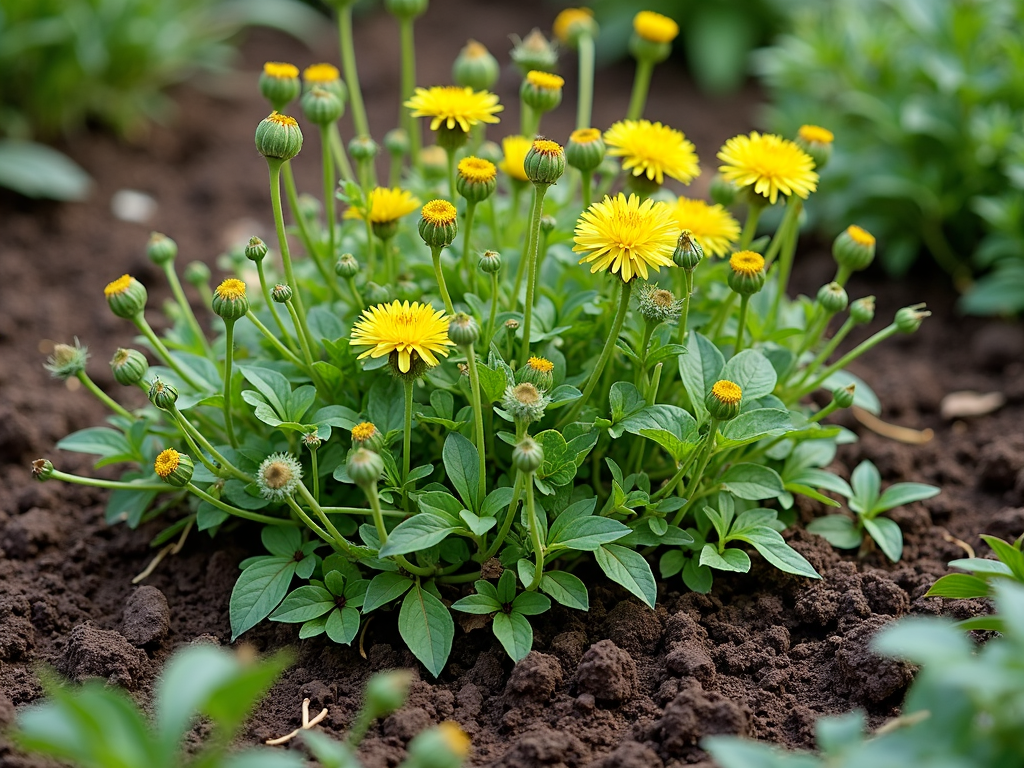
Overview
Introduction to Lawn Weeds
Lawn weeds are invasive plants that steal nutrients, water and sunlight from your grass, weakening its growth and ruining the look of your lawn. If you’re struggling with killing weeds in your lawn, the right strategy can make all the difference. In Shropshire, where well-kept gardens are part of the charm, weed problems can turn a tidy lawn into a patchy mess if not dealt with properly.
At Luxe Gardens, we work with clients who have weed problems and help them get their lawns back to full health. One of the first steps in effective weed control is to understand what you’re up against.
Different types of lawn weeds have different life cycles, and knowing how they grow helps you determine the best time and method of removal. Controlling weeds early is crucial to prevent them from spreading and expanding their root systems, which can make them harder to remove later.
Some of the most common weeds found in lawns are crabgrass, dandelions, and clover. These common weeds each have their own challenges. Crabgrass thrives in hot weather and bare patches, dandelions and clover—easily identified by their clover-like leaves—spread in lawns with compacted soil or poor nutrient levels. Knowing what you have allows you to choose the right treatment.
Prevention is just as important as removal. Good lawn care practices – regular mowing, proper watering and seasonal fertilising – can make a big difference. Applying mulch in spring is an effective way to prevent weeds from establishing in garden beds and landscape areas. Selective lawn weedkillers can also help manage outbreaks when used correctly.
Ultimately, a healthy well well-maintained lawn is the best defence against weeds. Focusing on improving your soil, choosing the right grass and maintaining consistent care will reduce the chance of weeds coming back in the future. Tackling weeds regularly is essential for maintaining a healthy lawn and achieving the goal of a weed-free lawn.
Understanding Lawn Weed Growth
Lawn weeds start their life cycle when seeds germinate and grow into mature plants. Weed seeds require moisture near the soil surface to germinate. These plants then produce more seeds, many of which can lie dormant in the soil for several years, waiting for the right conditions to sprout.
Weeds are fast-growing. Once they get established, they can outcompete grass and other desirable plants for water, sunlight and nutrients. Some weeds spread rapidly, especially in areas of the lawn that are thin or undernourished.
Some of the most troublesome weeds are perennials like creeping Charlie and ground ivy. These plants come back year after year and often spread through complex, deep or extensive root systems, so they can’t be eliminated with surface-level treatments alone. Persistent weeds like these are challenging to control and require targeted approaches. Established weeds are more difficult to remove due to their mature root systems.
Knowing the weed life cycle from germination to seed production is key. This knowledge helps you choose the right time and method for removal and prevention, whether manual or chemical.
Types of Weeds
Weeds fall into three main categories: grassy weeds, broadleaf weeds, perennial weeds, and creeping weeds. Perennial weeds, such as wild violet, are persistent and can return year after year, making them especially challenging to control.
Each type has its own characteristics and behaviour that determine how they spread and how hard they are to control. Aggressive plants like Canada thistle, which has sharp spines and spreads rapidly through its extensive root system, can quickly overtake lawns and gardens.
At Luxe Gardens, our first step when dealing with any weed problem is to identify what we’re up against. Different weeds need different treatments. For example, grassy weeds like crabgrass may need a pre-emergent herbicide applied in early spring to prevent them from germinating.
For best results, apply treatments when weeds are actively growing—early summer is often an optimal time. Broadleaf weeds like dandelions are often best treated with selective post-emergent sprays or iron-based herbicides.
Weeds with creeping stems like creeping buttercup need a combination of digging and spot treatment methods, as they can regrow from root fragments. It’s important to remove the entire root system to prevent regrowth. When applying herbicides, avoid mowing before and after treatment to maximise effectiveness.
Some of the most common lawn weeds are dandelions, which are resilient and spread quickly, clover, which thrives in under-fertilised lawns and can attract pollinators, and plantain, which tolerates compacted soil and low mowing.
Other problematic weeds include yellow salsify, recognised by its long stems and yellow flowers; Canada thistle, an invasive perennial with sharp spines and purple flowers; and poison ivy, which has three leaflets and can cause skin irritation—always wear gloves when handling it.
Weeds can also be identified by features such as blue-green leaves (prostrate knotweed), heart-shaped leaves (wild violet), purple flowers (henbit, creeping Charlie), and long stems (dollarweed).
Each of these can be removed effectively with a combination of manual removal—pulling weeds by hand—, weeding tools, and targeted chemical treatments like weed killer.
To get rid of stubborn weeds, use a combination of methods and remember to remove lawn weeds to maintain lawn health.
The key is to know what you’re dealing with. Choosing the wrong method can damage your lawn and not solve the problem, so matching the treatment to the weed is crucial for long-term results.
Incorporating organic matter into your soil can improve soil health and help suppress weeds. After weed treatments, applying lawn feed will help boost grass health and support a weed-free lawn.

Garden Weeds
Garden weeds can cause just as many issues as those found in lawns. They compete with your flowers, shrubs, and vegetables for nutrients, water, and space—often growing faster and more aggressively than the plants you actually want. In areas like Shropshire, where many gardens combine ornamental beds with functional planting, weed growth can quickly get out of control if left unmanaged.
Some of the most common culprits include yellow sweet clover, which can self-seed rapidly, common mallow, which thrives in poor soil, and bindweed, one of the most aggressive plants in gardens—a notoriously invasive climber that wraps around other plants and robs them of light and air.
Preventing garden weed growth starts with good soil preparation—turning the soil properly and removing existing root systems before planting. Mulching is also highly effective; applying bark or wood chips, compost, or other organic matter creates a barrier that suppresses weeds and helps retain moisture in the soil. This is especially useful during the warmer months when weed seeds are most likely to germinate.
Regular manual weeding is one of the most efficient long-term strategies to get rid of persistent garden weeds without harming your surrounding plants. Pull weeds by hand or with a dedicated weeding tool to remove weeds promptly and prevent them from flowering and seeding, reducing the need for chemical solutions and preserving the health of surrounding plants.
Best Methods for Killing Weeds in Your Lawn
When it comes to removing lawn weeds, there are several methods, each for different levels of infestation and types of weed. In Shropshire, where both rural and urban lawns get a variety of weeds, choosing the right method will save you time and your lawn.
The main goal is to remove weeds and remove lawn weeds effectively to maintain a healthy, attractive lawn and get rid of unwanted plants.
At Luxe Gardens, we recommend starting with hand removal for smaller areas or when weeds are young and not yet well rooted. Pull weeds by hand, making sure to remove the entire root system to prevent regrowth. This method is especially effective when you need to remove weeds from small, targeted areas without disturbing healthy grass.
Using a weeding tool will help extract roots more thoroughly, which is important to prevent regrowth. For hazardous weeds like stinging nettle or poison ivy, always wear gloves to protect your skin.
For widespread infestations, persistent weeds may require more thorough methods. Weed killers are often more suitable for these cases. Selective herbicides can target specific weeds without harming grass, making them a great option when you need to get rid of large patches of unwanted growth efficiently.
While non-selective herbicides are best used to spot treat individual weeds in paths, driveways or non-grassy areas. Spot treat persistent weeds for targeted control and to kill weeds without affecting the whole lawn. Always follow product instructions carefully to avoid harming healthy vegetation.
For best results, apply treatments when weeds are actively growing and avoid mowing before and after herbicide application to maximise effectiveness.
Another option is to use pre-emergent herbicides, which work by preventing weed seeds from germinating. Applying these at the right time – usually early spring or autumn – will reduce the number of weeds that appear in the first place, making ongoing removal easier.
After removing weeds, apply lawn feed to promote healthy, thick grass and improve overall lawn quality. As part of regular maintenance, mow regularly to prevent weed growth and keep your lawn looking its best.

Preventing Lawn Weed Growth
Lawn Maintenance to Help Kill Weeds Naturally
Ongoing maintenance is the key to weed prevention and achieving a weed free lawn. A healthy lawn is far more weed resistant as thick, vigorous grass leaves no room for weeds to get a foothold. In Shropshire where the weather can be wet springs and dry summers, regular lawn care helps manage these fluctuations and keep your lawn looking its best.
At Luxe Gardens, we recommend our clients adopt a proactive lawn care routine. This means mowing regularly—but not too short—to promote strong, dense grass.
Deep watering encourages roots to grow deeper into the soil so the lawn can withstand drought and outcompete weeds.
Fertilising at the right times of year with a quality lawn feed is essential for lawn maintenance, ensuring the grass gets the nutrients it needs to grow lush and healthy and helping to prevent weeds.
Also, aerating the lawn helps to relieve soil compaction so water, air and nutrients can penetrate more easily. Dethatching, which removes the layer of dead grass and organic debris from the surface, helps soil health and creates less opportunity for weed seeds to settle and germinate. Incorporating organic matter into the soil further improves soil health and helps suppress weeds.
Finally, regular inspections are a simple but powerful habit. By walking your lawn regularly and pulling weeds as soon as you see them, you can remove weeds before they spread rapidly or go to seed—keep your lawn under control without relying too much on chemicals.
This regular attention helps you remove weeds early and often, which keeps your lawn looking its best. Controlling weeds is a continuous process, especially when dealing with persistent weeds, so regular action is needed to remove weeds and maintain a weed-free lawn.
Conclusion
Removing lawn weeds isn’t just a one-off job. It’s a long-term approach that combines good lawn care, regular maintenance and the right removal methods – whether that’s hand pulling, using weeding tools or herbicides where necessary.
Getting rid of persistent weeds is crucial for long-term lawn health, as these stubborn invaders require targeted strategies to eliminate them effectively. Each method has its part to play in keeping unwanted plants at bay.
In Shropshire, we have a mix of weed problems due to the changing seasons and different soil types. It’s so much easier to stay ahead of the problems if you invest in prevention. A thick, healthy lawn will resist weed invasion and reduce the need for aggressive weed removal in the future.
At Luxe Gardens, we recommend a balanced approach to weed control that includes organic methods, like regular hand weeding and mulching, and chemical treatments when necessary.
We also stress the importance of mowing at the right height, deep watering and seasonal fertilising to strengthen your lawn and outcompete weeds over time.
Consistency is key to long-term success. With good care, your lawn can be lush, green and truly weed-free – an outdoor space you can enjoy all year round.
If you’re dealing with lawn weeds in Shropshire, get in touch for professional, tailored support.

